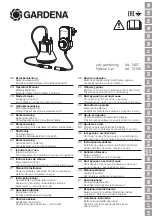
4. OPERATiOn
WARninG!
ensure you read, understand and apply the safety and operational instructions before connecting the tester
clamps to the battery. only when you are sure that you understand the procedures is it safe to proceed with the testing process
.
4.1. Preparation
4.1.1. check the battery casing for cracks or leakage and confirm whether 6 volts or 12 volts.
4.1.2. clean the battery terminals.
4.1.3. If practical, check the electrolyte levels and top up with distilled water as required.
4.2. connection
WARninG!
ensure the vehicle or battery is in a well ventilated area before starting to test.
4.2.1. Attach the positive red clamp to the positive (+) battery terminal. Attach the negative black clamp to the negative (-) battery terminal. use the
extended clamps if necessary. to ensure good electrical contact twist the clamps on the terminals two or three times. correct connection
indication will sweep the pointer clockwise across the voltage scale; if connected incorrectly the pointer will sweep anti clockwise. If there is no
movement from the pointer, it is either a bad connection or a dead battery.
4.2.2. ensure that the clamp cables are clear of hot or moving engine parts, especially if a starter or charging test is required. Ventilation slots in the
tester casing should not be obstructed and the meter scale easily visible with access to the load switch.
4.3.
Battery load test
note! On the first load test
,
smoke
may be emitted from the louvres in the tester casing, this is normal and temporary.
4.3.1. press the load switch in fig.2; hold until meter reading stabilises, or for a maximum of 10 seconds.
failure to release the switch inside 10
seconds may result in the switch burning out and your warranty being invalidated.
note the meter reading and then release the
load switch.
4.3.2. compare the meter reading with load test chart (4.4) to determine battery condition.
notes:
a)
For 12 volt batteries the green sector (fig. 1F) border is marked with nominal cranking current from 300 to 500 amps and stepped in
50 amp intervals. record this figure and compare with battery manufacturer’s quoted figure to give an indication of any deterioration.
b) Battery performance falls at low temperatures and quoted cranking amps should be reduced by 50 amps at 20ºF(-7ºc) and 100 amps
at 0ºF(-18ºc).
3. cOnTEnTS
fig.1
fig.2
Bt91/7.V3 Issue: 3(l) - 29/02/16
Original Language Version
© Jack sealey limited





















